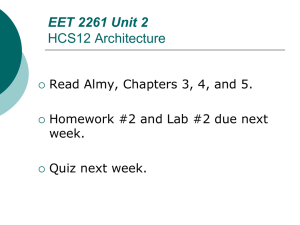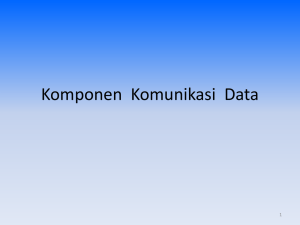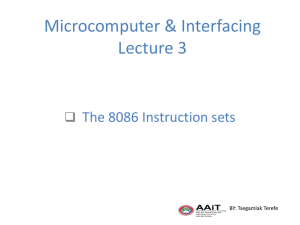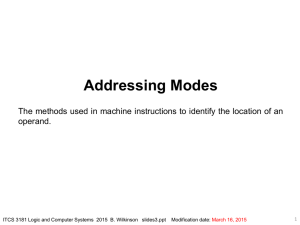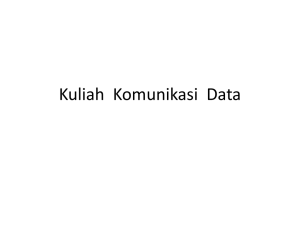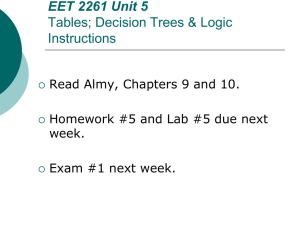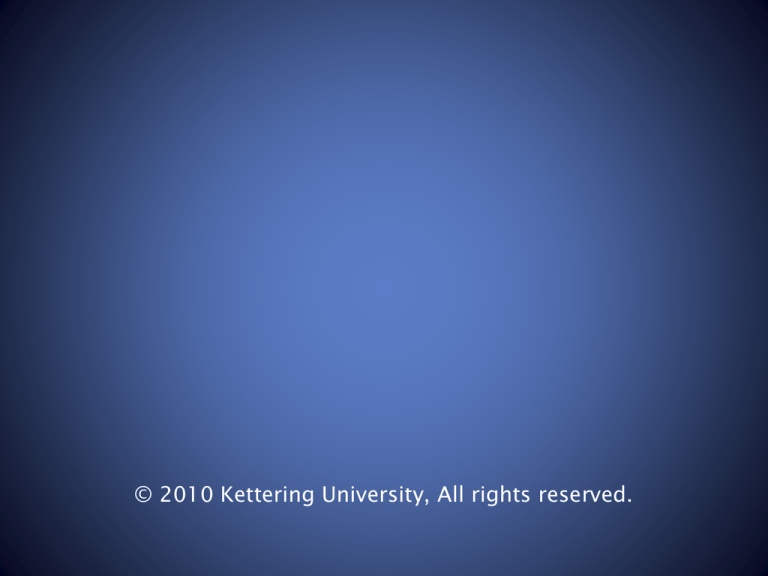
© 2010 Kettering University, All rights reserved.
Microcomputers I – CE 320
Jaerock Kwon, Ph.D.
Electrical and Computer Engineering
Kettering University
jkwon@kettering.edu
http://www.kettering.edu/~jkwon
Announcements
• No class on Monday.
• The first quiz on Wednesday!
–
–
–
–
Closed book and notes
No calculators are allowed
Topic: Number systems
Study Exercise 1!!
Lecture 4:
Addressing Modes
Today’s Goals
Two major goals
• Understand addressing modes so figure out how to use them.
– If you don’t get addressing modes, you will have a serious
problem to complete this course.
• Learn how to use a program trace.
Addressing Modes
How to get effective addresses
•
The operand of an instruction can use different methods for
specifying data in the memory (=addressing modes).
– If the data number is in registers (inside the microprocessor), a
memory address is not needed.
•
The HCS12 has six addressing modes
•
•
•
•
•
•
•
Extended (EXT)
Direct (DIR)
Inherent (INH)
Immediate (IMM)
Index (IDX)
Relative (REL) : Used only with branch instructions.
Effective Address
– The effective address is the location that holds the data to be used
by the operation.
– The operand is often used to construct the effective address.
– An addressing mode tells the microprocessor the way of calculation
to get the effective address.
Extended Addressing (EXT)
Also called Absolute Addressing
• Effective address:
.
.
2000
B6
2001
30
2002
00
.
.
3000
98
.
.
– No operation needed.
– Extended addressing tells the full memory address.
• Format:
– Two-byte hexadecimal number (4-digit) preceded
with a $. Actually ‘$’ simply means that the number
is a hexadecimal number. (A number could be
followed by ‘h’ excluding ‘’.
• Example:
– (Assuming the instruction is stored at $2000)
– LDAA $3000
• Load a byte value stored at address $3000 into the
register A.
• LDAA opr16a
(M) A
EXT B6 hh ll
• 98 A
Direct Addressing (DIR)
Also called Zero-Paging Addressing
• Effective address:
.
.
0080
98
.
.
2000
B6
2001
30
.
.
– This addressing mode only supplies the lower byte
of the address.
– Extend the one byte address to two-bytes by
concatenating $00 to the beginning of the operand.
• Format:
– One byte hexadecimal number (2-digit) preceded
with a $.
• Example:
– (Assuming the instruction is stored at $2000)
– LDAA $80
• Load a byte value stored at address $0080 into the
register A.
• LDAA opr8a
(M) A
DIR 96 dd
• 98 A
Inherent Addressing (INH)
Also called Implied Addressing
• Effective address:
– No operation.
• Format:
– No operand.
.
.
2000
42
.
.
• Example:
– (Assuming the instruction is stored at $2000)
– INCA
• Increase register A by 1
• INCA
(A) + $01 A
INH
42
Immediate Addressing (IMM)
.
.
2000
86
2001
80
•
– No operation. The data itself is supplied as the operand.
•
•
2001
03
2002
E8
.
.
Example:
–
(Assuming the instruction is stored at $2000)
– LDAA
#$80
.
.
CC
Format:
– Number preceded with a #. ‘#’ is followed by a number
that is a value instead of an address!
.
.
2000
Effective address:
• Load a byte value(the operand itself) into the register A.
• 8016 A
– LDD
#1000
• 1000 is 03E816 D (meaning 03 A and E8 B)
•
The size of an operand
– Register A and B have one-byte immediate operands.
– Register D, X, Y, SP, and PC have two-byte ones.
Index Addressing (IDX, IDX1, IDX2)
•
Effective Address
– Add the operand as a signed number to the value in the X, Y, PC, or S
registers.
•
Format
– Signed number, Register (X, Y, PC, or S)
•
Example:
– LDAA
0,X
• The effective address is the value(=address) in register X. (=X+0)
– LDD
-100,Y
• The effective address is 100 lower than the value in Y. (=Y-100)
– LDX
1000, Y
• The effective address is 1000 higher than the value in Y. (=Y+1000)
•
Notes:
– The value in the specified register is not changed.
– The smallest number of bits will be used to represent the address.
Index Addressing Postbytes
• An operand in the index addressing are called a postbyte.
• The postbyte tells the processor which two-byte register to
be used as the base address, the size of the offset.
Register
rr
X
00
Y
01
SP
10
PC
11
Postbyte for 5-bit Offset:
Postbytes for 9-bit Offset:
Postbytes for 16-bit Offset:
rr0nnnnn
111rr00n nnnnnnnn
111rr010 nnnnnnnn nnnnnnnn
Index Addressing
Examples
Instruction
Machine Code
LDAA 4,Y
A6
LDD -100,X
EC
LDX -1000,Y
EE
44
01 0 00100
E1
111 00 00 1
EA
111 01 010
Postbyte for 5-bit Offset:
Postbytes for 9-bit Offset:
Postbytes for 16-bit Offset:
9C
10011100
FC
1111 1100
rr0nnnnn
111rr00n nnnnnnnn
111rr010 nnnnnnnn nnnnnnnn
18
0001 1000
Register
rr
X
00
Y
01
SP
10
PC
11
Instruction Set
Source Form
LDAA #opr8i
LDAA opr8a
LDAA opr16a
LDAA oprx0_xysp
LDAA oprx9,xysp
LDAA oprx16,xysp
Operation
(M) A
Load Acc. A
Addr.
Mode
IMM
DIR
EXT
IDX
IDX1
IDX2
Machine Coding
86 ii
96 dd
B6 hh ii
A6 xb
A6 xb ff
A6 xb ee ff
Access Detail
P
rPf
rPO
rPf
rPO
frPP
SXHI
NZVC
----
10
• Above is a portion of the entry for the LDAA instruction.
• Now, we can better understand information in the HCS12
instruction sets.
Addressing Mode Summary
How to Get an Effective Address
INH
Op Code
IMM
Op Code
Data
DIR
Op Code
Addr-low
EXT
Op Code
Op Code
Data-high
Data-low
Effective Address
00
Addr-low
Effective Address
Addr-high
Addr-low
Addr-high
Addr-low
IDX
Op Code
Offset
Effective Address
Index Register
REL
Op Code
Effective Address
Relative offset
Program Counter
Program Trace
2000
B6
2001
30
2002
00
2003
C6
2004
02
2005
18
2006
06
2007
7A
2008
30
2009
01
200A
3F
3000
19
3001
FF
LDAA 3000h
• A diagram showing the contents of
the HCS12 memory which contains a
program.
ABA
• A program trace shows the contents
of the processor’s registers as the
program is executed.
STAA 3001h
• Very useful for debugging programs
LDAB #2
“Stop”
Program Trace
Example
Trace
Line
1
Address
2000
2
Instruction
PC
A
B
LDAA 3000h
2003
19
-
2003
LDAB #2
2005
19
02
3
2005
ABA
2007
1B
02
4
2007
STAA 3001h
200A
1B
02
5
200A
“stop”
-
-
-
Program Trace
Another Example
2000
CE
2001
30
2002
01
2003
EC
2004
01
LDX #3001H
LDD 1,X
2005
87
CLRA
2006
6C
STD -1,X
2007
1F
2008
3F
3000
EC
3001
27
3002
45
3003
99
Trace Address
Instruction
Line
1
2000 LDX #3001h
“Stop”
PC
X
A
B
2003 3001
-
-
2
2003
LDD 1,X
2005 3001
45
99
3
2005
INCB
2006 3001
45
9A
4
2007
STD -1,X
2009 3001
00
9A
5
2009
“STOP”
-
-
-
-
•
X requires a 2-byte operand with immediate
addressing since it is a 2-byte register.
•
Note that using indexed addressing to
load/store register D does not change the
value in register X.
•
What are the values in memory locations from
3000h to 3003h after the program is done
executing? 45-9A-45-99
Questions?
Wrap-up
What we’ve learned
• Five addressing modes
• Program trace
What to Come
• Unconditional branches
• Relative addressing mode




